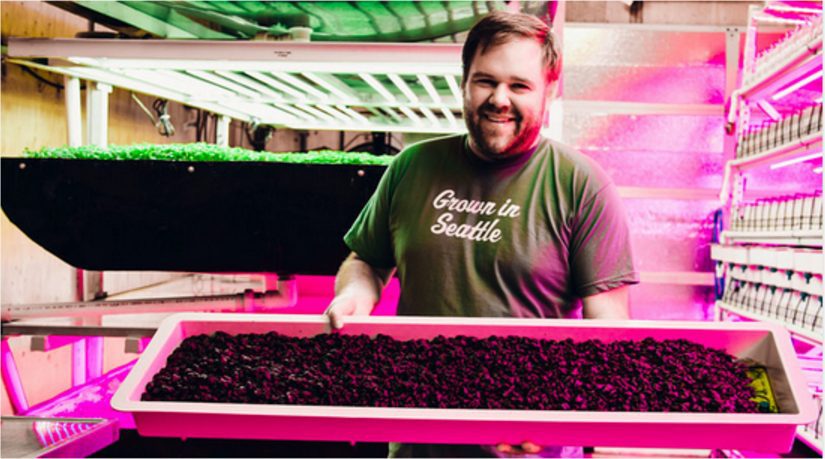Indoor farms are springing up everywhere, but vertical farming makes the most sense for intense production in limited space. But most of the operations you come across are big, far more than the average person could get into without grants and investors. That all translates into waiting years to get going. Not feasible if you lack the funding to even apply for grants, or the education that investors will look for. It gives you the idea that you have to have lots of cash to be a successful urban farmer, and a lease on an vacant warehouse or factory. A structure that will need a huge amount of repair and retrofitting.
This isn’t true at all. You don’t need a huge building, grant money or investors to turn vertical farming into a profitable business. Check out these two urban farmers who started highly successful businesses at home.
City-Hydro in Baltimore developed in a spare bedroom after Larry Hountz suffered severe injuries in a car accident. He was left home-bound and unable to work for two years. Some fresh heirloom tomatoes brought him to realize he could grow tomatoes at home to generate income. Yes, he likely could grow them indoors after investing in some dutch bucket hydroponic systems, and super powerful lights that would run 16 hours a day for several months before the first tomato was ripe. It’s not the best suited crop for production in a 10′ x 15′ room with the limitations of an 8′ ceiling. Definitely not a money maker.
Microgreens, however, are an entirely different scenario. They’re the perfect crop for vertical farming in that extra room, a corner of the basement, a shed, or the garage. No matter what kind of seed you sow, the crop is ready for harvesting in 10-14 days, giving you 2 crop rotations a month. It’s fast turnover. A crop that grows well under power-saving LED grow lights. The plants never reach more than a couple of inches tall, so you can get a up to 8 trays in a rack without high ceilings. In short, it’s rapid production on a super intensive scale of a food that is in high demand by restaurants, grocers, and consumers. Greens, herbs, and vegetable shoots are all prime candidates for being grown as microgreens.

Larry in his bedroom turned vertical farm. (Courtesy of Dining Dish)
Larry’s in-home farm generates $120,000 a year in profit from about 80 different kinds of microgreens and baby greens. They sell their harvests to local chefs and a grocery store chain. His harvest is grown in just 150 square feet of space. He grows totally without soil or soilless mixes ensuring the cleanest greens are delivered to his customers. He could grow his business, but has no interest in doing so. Keeping it a small mom and pop operation fits their needs.
On the other side of the country in Seattle, Dan Albert is vertical farming in his garage. The very first indoor farm in the city, FarmBox Greens operation grows microgreens too. However, having a lot more floor space than Hountz, his annual sales are also higher. He started out small in 2012, but has grown to produce $500,000 a year in just 500 square feet. Dan has 3 employees, and has recently quit his job to be a full time urban farmer.
There are several things that sets these vertical farming operations apart besides distance and size. Unlike City-Hydro, Dan will definitely keep expanding his farm. It made a lot more sense to him to start small, and increase the size of his operation as sales and demand grew. Smart guy. Investors take a big bite out of profitability. Grow your microgreen farm slow, and it will belong solely to you. If you fail to generate enough profit with investors involved, they’ll just remove you from the equation. Not much different than traditional farming, or corporate ventures.

Dan in his garage turned vertical farm. (Courtesy of FarmBox Greens via Facebook)
While Hountz grows his crops with nothing but water in food-safe trays on chrome racks, Albert has a more technical approach. He uses a modified NFT system. A seed does contains enough nutrition to provide for the plant through developing the first two immature or cotyledon leaves, but well-finished microgreens have two mature shaped leaves and have started photosynthesis. They should have a regular grow nutrient available during the stage between the two types of leaves developing. Dan’s using a nutrient film system with Phillips LED Production Modules. He also has added a Hannah nutrient dosing system to ensure the EC and pH are precise.
In it’s early days, FarmBox Greens offered baby greens, but he’s stopped growing them entirely. They are space hogs, adding another week to the time between sowing and harvest. If you’ve got space limitations as tight as these guys, the faster you harvest a crop, the more money you can earn in a year. You can grow two crops of baby greens in the same amount of time as 3 crops of microgreens, and sell for about the same price each.
Obviously, the microgreens are a much better cash crop. Dropping them from the lineup hasn’t put a damper on sales. Dan is growing up to 20 types of microgreens and herbs. It keeps his chefs and farm market customers happy, and allows 52 or more harvests a year from his small garage farm. His thousands of pounds of yearly harvests are processed in the same building that is also outfitted with refrigeration to keep the produce at its best until delivery.
Two very different styles of vertical farming microgreens. Each startup business launched without investors or grant. They both produce enough harvests at home to make being farmers a successful way of generating income.
Learn More:
- City-Hydro website
- City-Hydro Instagram page
- FarmBox Greens website
- FarmBox in UrbanAg magazine
- Source: New York Times